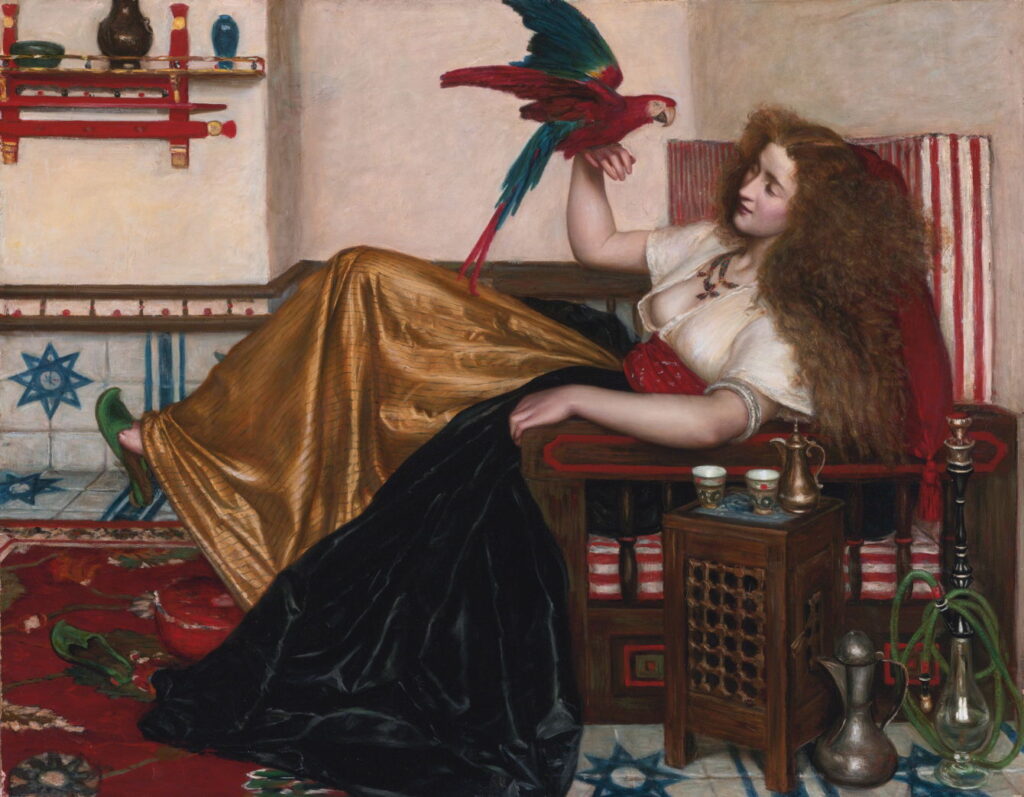Reading Visual Art: 209 Parrot A

Parrots, parakeets, cockatoos and the humble budgerigar (a small parakeet) have long been popular domestic pets in Europe, and haven’t escaped the attention of artists. According to Richard Verdi, who has written a monograph on the subject, they appear in many paintings, often being symbols of the Virgin birth of Christ, or witnesses of the Fall of Man. In this week’s two articles considering the reading of paintings, I show a selection of works featuring these birds in different roles.
Parrots have been added to mythological paintings to supplement their original story.
Jacopo Tintoretto (c 1518-1594), Leda and the Swan (E&I 221) (c 1578-83), oil on canvas, 167 x 221 cm, Galleria degli Uffizi, Florence, Italy. Wikimedia Commons.
In Tintoretto’s Leda and the Swan, from about 1578-83, there are two caged birds, a duck being taunted by a cat in the left foreground, and a parrot in the background. These allude to one of the most bizarre of Jupiter’s many rapes of mortal women, here in the form of a swan, resulting in his victim Leda laying eggs.
Giovanni Battista Tiepolo (1696–1770), The Death of Hyacinthus (c 1752-53), oil on canvas, 287 × 232 cm, Museo Thyssen-Bornemisza, Madrid, Spain. Wikimedia Commons.
Tiepolo’s magnificent Death of Hyacinthus from about 1752-53 was inspired by an Italian translation of Ovid’s Metamorphoses from 1561, where the fatal discus is replaced by what looks like a tennis ball, actually taken from the popular game of pallacorda. This classical story is told in the right foreground, with the pale Hyacinthus visibly bruised on his cheek, Apollo swooning above him, and Cupid to the right. Above that group is a grinning Pan in the form of a Herm, and at the top right a brightly coloured parrot, who appears oddly out of place.
Peter Paul Rubens (1577–1640), The Fall of Man (after Titian) (1628-29), oil on canvas, 238 x 184.5 cm, Museo Nacional del Prado, Madrid, Spain. Wikimedia Commons.
Peter Paul Rubens’ version of The Fall of Man painted in 1628-29 changes Titian’s original depiction of Adam and adds a parrot as witness to Eve taking the apple from the serpent with a child’s head and body.
Alfred Stevens (1823–1906), The Psyché (My Studio) (c 1871), oil on panel, 73.7 x 59.1 cm, Princeton University Art Museum, Princeton, NJ. Wikimedia Commons.
Alfred Stevens was an early enthusiast for Japonisme as it swept Paris, and provided insights into his life in his Psyché or My Studio from about 1871. The French word psyché refers to the full-length mirror seen in this apparently informal view of Stevens’ studio, the name deriving from the legend of Cupid and Psyche. For this painting, Stevens doesn’t use a genuine psyché, but has mounted a large mirror on his easel, suggesting that art is a reflection of life. A Japanese silk garment is draped over the mirror to limit its view to the model, and breaks up her form in an unnatural way. At the lower right, the artist indicates his presence with a cigarette, and there’s a small parrot who might imitate his speech.
The association between parrots and beautiful women has a long history.
Jacopo Tintoretto (c 1518-1594), Summer (c 1546) (E&I 40), oil on canvas, 105.7 x 193 cm, The National Gallery of Art (Samuel H. Kress Collection), Washington, DC. Courtesy of the National Gallery of Art.
Tintoretto’s Summer (c 1546) poses a reclining Titianesque nude before she removed her clothes against the summer harvest ripening behind her. She is joined by three birds, one an exotic parrot, with flowers of the dog rose, and hanging bunches of grapes.
Valentine Cameron Prinsep (1838–1904), The Lady of the Tooti-Nameh, or The Legend of the Parrot (c 1865), oil on canvas, 91.4 × 116.5 cm, Private collection. Wikimedia Commons.
In 1858, a popular translation of tales in Persian by Ṭūṭī-nāma of Żiyā’ al-Dīn Naḫšabī, who died around 751/1350-51, was published in Britain. Valentine Cameron Prinsep’s Lady of the Tooti-Nameh, or The Legend of the Parrot (c 1865) refers to that book, and was first exhibited at the Royal Academy in 1865, where it must have caused quite a sensation with its fleshly glimpses inside the woman’s blouse. The parrot perched on her hand is a hint of the exotic, but couldn’t have anticipated the painting shown by Gustave Courbet in the Paris Salon the following year.
Gustave Courbet (1819–1877), Woman with a Parrot (1866), oil on canvas, 129.5 x 195.6 cm, The Metropolitan Museum of Art, New York, NY. Wikimedia Commons.
Courbet’s model for his erotically charged Woman with a Parrot from 1866 was Joanna Hiffernan. The structure behind and to the right is a perch and feeder for the bird. This inevitably brought scandal, but didn’t deter others from painting pretty women with parrots. Édouard Manet’s A Young Lady in 1866, nicknamed Woman with a Parrot, was shown at the Salon two years later, and Auguste Renoir’s Woman with Parakeet followed in 1871, although at least their models were decently dressed.
Henry Tonks (1862-1937), A Girl with a Parrot (c 1893), oil on canvas, 45.7 x 31.1 cm, The Tate Gallery (Presented by W.C. Alexander through the Contemporary Art Society 1917), London. © The Tate Gallery and Photographic Rights © Tate (2016), CC-BY-NC-ND 3.0 (Unported), http://www.tate.org.uk/art/artworks/tonks-a-girl-with-a-parrot-n03186
Henry Tonks’ early portrait of A Girl with a Parrot from about 1893 provides an intimate glimpse into the private world of a young girl.
John William Godward (1861–1922), Dolce Far Niente (1897), oil on canvas, 77.4 x 127 cm, Private collection. Wikimedia Commons.
A brilliant green parakeet with its bright red bill adds colour to John William Godward’s Dolce Far Niente from 1897.
Émile Friant (1863–1932), The Birds (1921), oil on canvas, 165 x 118 cm, Private collection. The Athenaeum.
Painted late in his career, Émile Friant’s The Birds (1921) is a brilliantly colourful and detailed erotic fantasy demonstrating his great technical skills, but has drifted far from his earlier Naturalism and social concerns.




